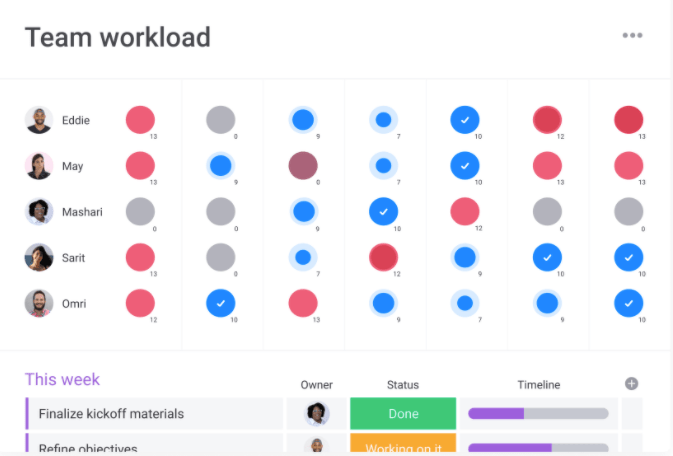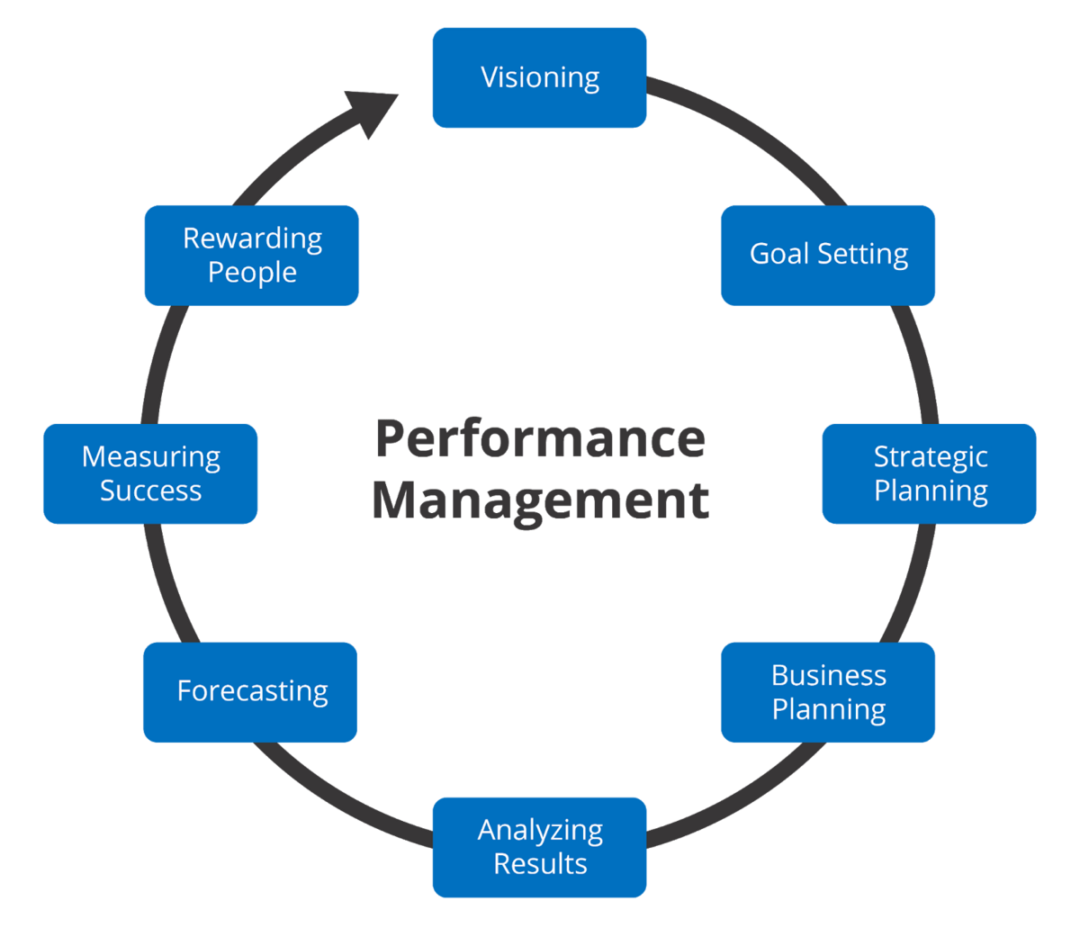How to create a winning performance management process
Blog: Monday Project Management Blog
Every company wants happy and motivated employees.
Especially considering recent research found a positive correlation between happy employees and satisfied customers. If your employees are happy, they work harder, and the customer benefits.
But how do you ensure employees stay motivated and continually improve their performance?
One way is through building a performance management process that works for your business and your people.
In this article, we’ll define the performance management process, outline some key benefits of implementing one, and show you in 4 steps how to implement your own while harnessing the power of monday.com:
What is a performance management process?
Performance management is exactly as it sounds. It’s the process of managing employee performance.
In technical terms, the performance management process is a collaborative effort between management and their employees where they work together to make observations, set a plan, and monitor the performance toward achieving specific objectives.
In simple terms, the performance management process helps leaders and employees get on the same page about what’s expected of them and how they can achieve their goals.
It goes further by providing the tools, knowledge, and support needed through various communication milestones. Management will help individual employees boost their performance by setting goals, checking in with them at certain intervals, and offering up feedback.
When performed correctly, it’s a rewarding process for both employees and management.
And, of course, the greater the employee performance, the more the organization as a whole benefits. These benefits apply to both small and large organizations alike.
While larger organizations have more resources and sophisticated means to provide performance management, that gap is getting smaller by the day, thanks to affordable technology that enables performance management activities.
What are the benefits of implementing a performance process?
A good performance management process will keep your employees motivated and performing at a reasonable level.
A great performance management process will help your employees exceed expectations and help you meet your company’s strategic goal more efficiently.

The positive outcomes of a solid performance management system benefit your organization tenfold.
Employee individual performance soars because continuous feedback provides the insights needed to recognize and address blind spots, bottlenecks, and knowledge gaps.
A thorough development process delivers employee recognition opportunities and improves employee engagement which boosts morale, retention, and ultimately reduces turnover for the organization.
Continuous performance management is the key to unlocking the potential your organization always had. In short, employees are supported to make the greatest contribution possible to the company’s success.
4 key elements of a performance management process
New research says 88% of senior managers worry about losing top talent.
Keeping a consistent performance management cycle going provides insight into employee performance, satisfaction, and morale. That means fewer worries and more opportunities to drive the mutual outcomes both parties seek.
Here are 4 essential elements of the performance management process:
1. Planning
Without planning, you’re essentially guessing when it comes to improving your employee’s performance.
Ideally, management would meet with employees at least quarterly to do some goal setting and create a concrete performance plan.
The objective is to establish SMART goals, which mean they’re specific, measurable, attainable, relevant, and time-bound. Without such goals, the performance management process would be difficult to track both short-term and long-term.

Here’s where monday.com comes in handy. You can put each employee’s goals into action by assigning specific tasks to them.
Each task can have a status, timeline, due date, and priority level, which helps direct their day-to-day actions. All of this is easily accomplished with a monday.com team planning board.
2. Communication
Proper planning is worthless without proper communication.
Employees need to know what performance standards, performance expectations, and specific goals you’ve set for them — otherwise, they’ll have no chance of meeting them.
The sooner you can explain the process and lay out employee goals, the closer you’ll get to meeting your company’s main objective. That also means ensuring they understand how they’ll be measured and what rewards or consequences may be tied to their performance.
Here’s yet another area where monday.com shines. You can implement specific boards for projects and communicate with your employees instantly. You can assign tasks, tag them to ask questions, and even get status updates in real-time.
3. Reviewing
Planning and communication are excellent first steps toward performance improvement, but they’re nothing without a proper follow-up.
Your team craves ongoing feedback and constructive feedback, whether they express it or not. They want to know what they’re doing right, what they could do better, and how they stack up to their peers.
One of the best ways to do this is by implementing weekly or bi-weekly 1-on-1s. During this time, they can ask questions, and you can review each employee’s performance metrics.
Over time their competency — or lack thereof — will shine through, and you’re able to adapt accordingly.

It’s never a bad idea to get into a formal review process on top of regular 1-on-1s. A quarterly, semi-annual, or annual appraisal meeting is standard for most businesses.
You can dive deeper during these reviews and compare role scorecards to employee performance and the goals you set.
The performance appraisal process will go even more smoothly if you leverage monday.com’s survey features.
You can ask your direct reports specific questions that gauge their overall engagement.
Or you can deploy a 360-degree feedback survey where each employee gets a survey about their colleague to offer up feedback on what’s going well and what they might work on improving.
That way, you get multiple avenues of feedback.
4. Support
Good performance feedback isn’t just planning, communicating, and offering feedback. It’s also about regular support.
The day-to-day isn’t as static as we’d like it to be. Some employees will go through personal issues or performance slumps. Others will require more hand-holding or a completely different approach.
Based on what you discover during the appraisal process, this is an opportunity to provide personalized support options such as training, coaching, or mentoring.
To stay on top of these check-ins, monday.com has robust task management features that include the ability to set milestones, automate reminders, and take notes.
All those features combined spread your reach and give you an edge during performance coaching conversations.
You can also lean on monday.com’s workload management view, which helps you keep tabs on who’s overworked, who can take on more, and who has the right amount.

Taking employee performance further with monday.com
monday.com is far more than a simple performance management tool. It’s a comprehensive Work OS that allows you to create custom workflows for every area of your business.
That means your sales pipeline gets connected to employee onboarding and even performance management.
That level of interconnectivity streamlines your day-to-day processes and provides insights not possible with traditional software solutions.
The key to improving team performance ultimately boils down to the systems you deploy and the processes you have in place. monday.com makes the performance management process both easy and scalable by giving it an established workflow.
Beyond the features we’ve outlined above, there are countless others you’re sure to love, including:
- 200+ custom workflows that enhance your team’s ability to not only do their work but exceed expectations
- 30+ column types that provide a unique canvas for all your operational processes
- 8+ unique data visualizations ranging from timeline and Gantt view to Kanban and workload, so your data is always in its proper form
- Unlimited automations which actively take work off your plate, reduce human error, and save you money
- Dozens and dozens of integrations, so every tool in your arsenal is connected to one central resource
As you can see, boosting employee engagement and performance has a lot to do with the tools in your arsenal. monday.com is both feature-rich and simple to use, which makes it the perfect solution for leaders and employees alike.
Beyond optimizing your performance management processes, monday.com offers a wide variety of add-on applications that extend the reach of the system and ultimately enable you to do more with less.
Driving employee performance
The key to consistent performance improvement and employee engagement lies in proper leadership.
Every employee wants to perform at a higher level and make a greater contribution to the organization. Each one wants to smash through performance goals and ultimately feel useful.
Where they often fall short is feeling discouraged due to lack of coaching and recognition. When they feel heard, rewarded, and propped up, they’ll almost always perform better.
The key to employee development is harnessing the power of monday.com and implementing a consistent performance management process.
Why not start by giving our Employee Annual Review template a whirl? It takes minutes to get started and works wonders toward meeting your organization’s goals.
The post How to create a winning performance management process appeared first on monday.com Blog.
Leave a Comment
You must be logged in to post a comment.







